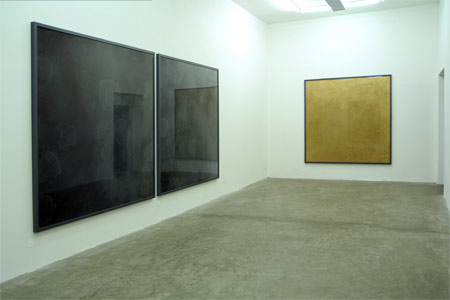SEHLER – SULTANA
The new body of work by Stefan Sehler presented by Galerie SULTANA is part of the artist’s explorations of abstraction. Here he shows monochromes (grey, reds, golden or bronzed) created according to his technique belonging to this most singular mix of painting and photographic appearance, with the ensemble of issues of recognition and definition that it induces.
Stehan Sehler works with fascinating precision and finds himself on the frontier of entrenchments of painting, between opposition and complementarity, between representation and abstraction in a dynamic and unique evolution in relation to the heritage of German painting and its future potential.
His painting leaves a place for a gestuality and new expressiveness. He plays with his medium, experimenting directly on the Plexiglas surface with sprays, dripping or his fingers – but rarely with a paintbrush. Even if sometimes, you can easily imagine recollections of photographs of the lunar surface or the cosmos, very quickly you realise that these works no longer have a relationship to the image and that the effects of the medium or finger traces in certain works are purely abstract. Here, drawing no longer intervenes as was the case with preceding works, thanks to cleverly used caches. His colour range also evolves and goes from a deep red to a metallic grey to go on to the golden or bronze.
It is work that is perturbing in itself, that destabilises our bearings with its strangeness, by the almost impossibility of identifying the nature of the work before which we find ourselves. The spectator, confronted by the glistening surface of the work, firstly perceives a uniformly smooth surface closely resembling photography but rapidly realises that it is really something else – for we quickly perceive the depth of space that bathes the shapes behind the Plexiglas. Everything happens in an abnormal way. It is true that all pictorial medium, well presented, despite everything, is squashed, visually smoothed by the Plexiglas. A certain distance is established in this way between the work and the viewer. Stefan blurs bearings we are used to in terms of photography. Whereas generally, the image becomes more precise as you go along as you get closer to the print, in this case the opposite occurs: from far away the image is just as precise as a carefully taken shot, looking at the work up close, the modulations of detail appear and the paining leaves you guessing.
Stefan Sehler borrows and adapts his techniques from the very old antique practice of reverse glass painting: presentin Egypt, Syria, Phoenicia, then Rome and Byzance before Venice made the technique famous. Then more recently this genre was taken up in Bavaria, in Bohemia and Lower Austria. Artists like Francis Picabia, Paul Klee, August Macke,
Man Ray or Vassily Kandinsky devoted themselves to it. In the work of Stefan Sehler, glass is replaced by Plexiglas.
Instead of being the protective element of the painted surface, something that comes along at the end and does note intervene in the creative act, it becomes the support for the painting and conditions it.
Stefan Sehler was born in 1958 in Nuremberg, he lives and works in Berlin. He has received numerous grants for his work including from PS1 and FRAC Pays de la Loire. His work was recently presented in a solo show at the Nice Contemporary Art Museum (2009). Stefan Sehler’s paintings can be found in many private and public collections: Deutsche Bank Collection (London and Frankfurt), Siemens Art Program, Victoria Versicherung, Kunstmuseum, Düsseldorf, FRAC Pays de la Loire, FRAC Haute Normandie, Fondazione Sandretto re Rebaudengo, Hôtel Cheval Blanc Collection at Courchevel, Mamac, Nice, as well as Heinz Ackermans Collection. Two publications document his work made by the artist’s galleries Kuttner Siebert, Parker’s Box, Cosar, and Galerie Sultana (2006) and the second catalogue was produced for the exhibition at Mamac in Nice (2009). Finally, his work has been warmly received by critics from Artforum, ArtPress, le Journal des Arts and Whitewall Magazine.
